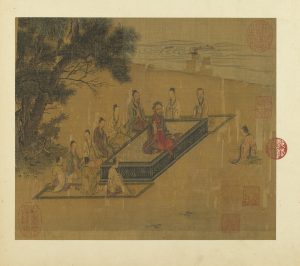Students taking your course should become both more knowledgeable and more articulate about its content. You, of course, are already more knowledgeable and articulate than most on the subject, which is presumably how you got the teaching gig. That means that if there’s something in the readings for the course that you think is interesting then it’s probably worth the students’ time to learn it too. They may not find it as interesting as you do, and they may not be able to converse about it as intelligently as you can, but they should be able to sense its relevance in the context of your teaching.
With this in mind, find a single page in the course literature you have already covered that contains a fact or notion that interests you. It’s important to emphasize to the students that there’s something on this page that you find very interesting. It’s also important to remind them that this should not be the first time they’re reading the page; it was at one time part of their class preparation. Finally, make sure they know the full agenda for the class, i.e., what will happen for the next 45 minutes.
Here’s the exercise:
- Give the students five minutes to read the page and identify the most interesting thing (to them) on it.
- Have them write down a simple, declarative sentence that states the interesting fact or defines the interesting notion.
- Give them five minutes to think about what they might say if they were given three minutes in front of the class to present it.
- Give them 14 minutes to write a paragraph that presents the fact or notion in the most interesting way they can.
- Select two or three students at random to come down in front of the class and make those three-minute presentations but do not let them bring their paragraph or the source with them.
- In the time that remains (of a 45-minute lecture), have them edit and proofread their paragraphs.
- Have them hand in their work.
Read all the paragraphs before the next class. Begin the class by asking two or three students to make a three-minute presentation. Choose them on the basis of the work they submitted — perhaps according to whether they found the same thing that you did interesting. Also, choose two or three paragraphs to look at with the whole class. These should be selected because they offer an occasion for you to show them something about writing, because they display either notable strengths or notable weaknesses.
The important thing to get across is that students in your class should be able to do these things well. You aren’t asking them to do anything more than demonstrate knowledge and articulateness about the subject matter of the course. If they find the exercise extremely difficult or even impossible to carry out they should be told that they need to practice more, study harder. But make sure they understand that competence here is a relative matter. It’s fine that it takes an effort on their part. It’s also fine that they aren’t entirely satisfied with the result — they weren’t given ideal conditions to work under, after all. But what you are asking them to do is not at all absurd. That’s the important thing to emphasize.
Finally, remind them that what you’ve just made them do they could choose to do on their own at any time. Any page of the assigned readings will do. They can pick one at random, or they can ask a classmate to pick one for them. If necessary, they can hold the talk in front a mirror, but it’s obviously a great idea to do this in pairs or in a study group. It can (and really should) be done regularly. It should be as naturally a part of preparing for class as reading a book. Instead of the comments you give in class, they can give each other some unfiltered feedback.

